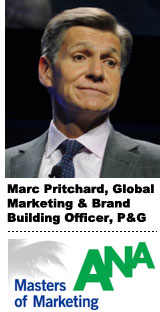 As often happens with ad industry events, the ANA’s Masters of Marketing conference in Orlando has a front channel and a back channel. On the front channel, speakers are tackling big creative and consumer themes like the rise of cause marketing, “social by design,” and brands as content creators. On the back channel digitally focused attendees are gnawing on some of the more complex, data driven issues facing the ad sector. Below are a few comments and observations from people AdExchanger has spoken with and heard speak, starting with the data-driven comments.
As often happens with ad industry events, the ANA’s Masters of Marketing conference in Orlando has a front channel and a back channel. On the front channel, speakers are tackling big creative and consumer themes like the rise of cause marketing, “social by design,” and brands as content creators. On the back channel digitally focused attendees are gnawing on some of the more complex, data driven issues facing the ad sector. Below are a few comments and observations from people AdExchanger has spoken with and heard speak, starting with the data-driven comments.
Rob Norman, CEO at GroupM North America talked at length about the multi-channel attribution challenge. “There’s no pure math way of getting it, there’s no single vendor way of getting it, there’s no single channel way of getting it.” On the interplay between GroupM agencies and the Xaxis trading desk, he said, “We are very keen to have the agencies get very wise and be able to tell the machine what to do… The trade desk will become a multivariate object. It’s our job from a central point of view to look after things like speed, accuracy, good UI, and good reporting.”
Greg Silverman, CEO of predictive modeling firm Concentric, talked about predictive analytics and his firm’s complexity science-based approach. And Laston Charriez, SVP marketing at Western Union, noted that his brand’s promising data optimization efforts must contend with an internal data fatigue.
These hallway discussions would have been in the weeds for the client-side marketing execs on stage. Which is not to say the CMO concerns are dull or uninteresting.
For instance, Procter & Gamble’s Marc Pritchard, Global Marketing & Brand Building Officer, described the CPG giant’s shift to more real-time messaging. Earlier this year, the marketers at its Tide brand capitalized on a high profile NASCAR crash, after which Tide was used (as it commonly is) to clean up spilled jet fuel. They launched a contest, crowdsourced a bunch of ads, and by Friday completed and trafficked a new 15-second spot. That Sunday afternoon it aired during a NASCAR race in Phoenix, one week after the crash. By the time it did, Pritchard the Tide Newsdesk, which handles social listening and engagement, had already shifted its attention to states hit by tornadoes, where the company would lend aid through the cause-driven “Loads of Hope” disaster relief program.
P&G took a similar approach to real-time ad creation during the 2012 Olympic Games in London, using the tagline “Proud Sponsor of Moms” and recent footage of athletes.
Johnson & Johnson meanwhile had a similar story to tell about social media. Kimberly Kadlec, Worldwide VP of Global Marketing, said, “The intimacy digital has allowed us has made it not only more complex but given brands the opportunity to connect on a human level.”
She was one of the few presenters to address data complexity, saying, “It’s less about the collection because you can measure everything. That’s the problem. You need to figure out what are the outcomes you need… It’s about setting priorities. As long as you know going in what your outcomes should be, that’s the discipline we go with.”
MasterCard, like P&G, is attempting to reinvent core tenants of its marketing without getting rid of what’s worked in the past. But whereas P&G is iterating on process, MasterCard is reinventing the creative around its 15-year-old “Priceless” campaign. A new Priceless Cities campaign is midway through its global rollout, and is based on the idea of city pride.
Having launched already in New York, London, Toronto, Chicago, Beijing and Sydney, this week it moves to Rio De Janeiro.












